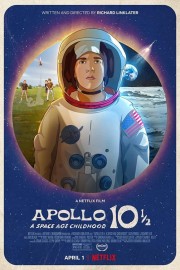Apollo 10 1/2: A Space Age Childhood
Richard Linklater approaches animation as a way of diving into ideas of philosophy and life that require some visual imagination. One of the most exciting things about his 2001 film, “Waking Life,” was how he explored the ways in which we interact with life, and ourselves, by having his protagonist (Wiley Wiggins) be confronted by people in his dreams. Though we never see him awake, we wonder if he will take these ideas, if he manages to wake up, and live life a bit differently than he did before. Moments like the one Wiggins has in that film, they have a way of bringing us to a sense of clarity about the world. In a way, “Apollo 10 1/2” is mining the same territory, but in a coming-of-age narrative.
The first thing that strikes me about “Apollo 10 1/2” is how much of the film is laid out in voiceover by Jack Black. Rather than using narration to simply introduce moments, and set context, for things we’re seeing in Stan’s life, he basically narrates the feeling he (as the older Stan, looking back on his life) had growing up in the 1960s, leading into the moment when man landed on the moon. In that way, this is much closer to Richard Dreyfuss’s narration in “Stand By Me,” but while Rob Reiner let that film unfold, Linklater lets Black’s voice, and the images we see, give the film a sense of memories being remembered. This is like a collection of home movies, being watched for the first time in decades. It is a hugely entertaining experience.
Linklater’s animation style, in which he rotoscopes over live-action footage, has gotten infinitely more confident than the always moving images of “Waking Life,” and even the more polished- but still in-progress- approach in 2006’s “A Scanner Darkly.” Here, you would think we’re watching a film that is native to the art form, and it is refreshing to see that he chose to take his time on his latest outing in animation. The story he chooses to tell is worthy of it, as Stan- a young boy living with his family (including brothers and sisters) in Houston- recounts growing up in the shadow of NASA, at the height of the Cold War, and at a time where America was going through profound changes. The first 30 minutes is almost wall-to-wall narration and music, even when Stan finds himself recruited by NASA to do a “test flight” for the moon. Wait, what? That’s where this film goes from memory piece to fantasy, and you know what? I love it. Linklater’s tapping into what it must have been like for children then to see the space race, and imagining what it must have felt like. Believable? In no way, shape or form. But emotionally honest? Very much so.
Richard Linklater is one of those special filmmakers whom can make any sort of story feel unique and like something we’ve never seen before. The way he builds the family in this movie around Stan, how he lays in the father working for NASA- but not in a way Stan can appreciate, and the way this family genuinely cares about each other, is such a breath of fresh air compared to most coming-of-age films. Much like how he let communication and listening show Jesse and Celine who the other was in the “Before” trilogy. And how time showed us how another child dealt with growing up in “Boyhood.” and how people looked at the rites of passage of moving into, and from, high school differently in “Dazed and Confused.” At the heart of it all, Linklater boils it down to character beats, and the emotional truth of the situation. He always allows us into what matters most to his stories, and here, it’s remembering what made that moment in June 1969 so indelible a memory for people, most of all, him.










